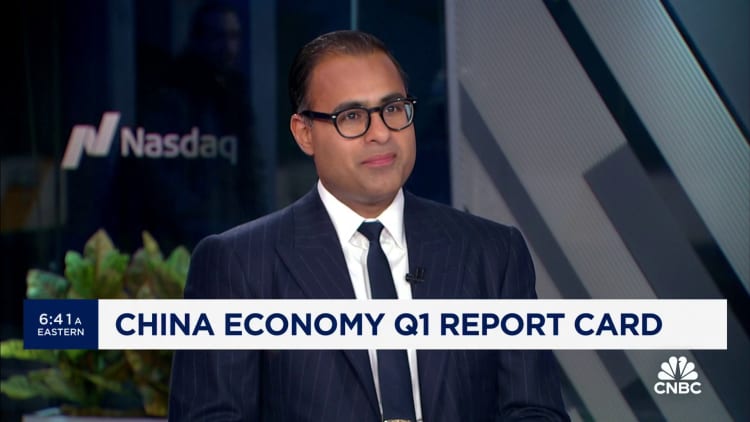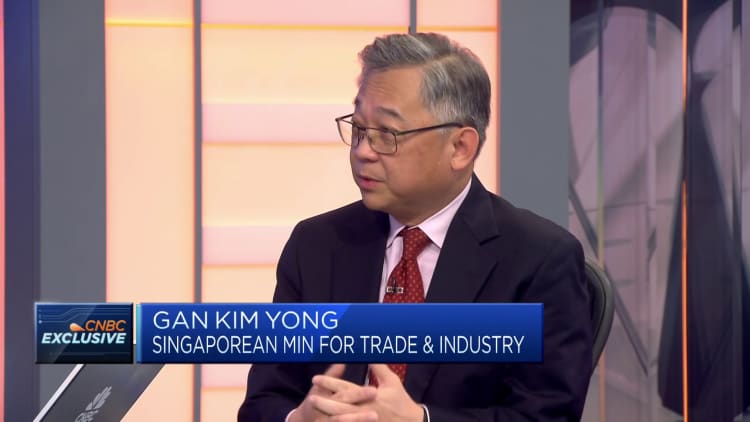An employee works on the assembly line of intelligent machinery at a workshop on March 31, 2024 in Qingzhou, Weifang City, Shandong Province of China.
Vcg | Visual China Group | Getty Images
BEIJING — China’s latest policy to boost demand will soon have a greater effect on growth, a top official at the economic planning agency told reporters Thursday.
Amid international concerns about oversupply in China and slower growth, Beijing earlier this year announced plans to bolster domestic demand with subsidies and other incentives for equipment upgrades and consumer product trade-ins.
That’s officially expected to create well over 5 trillion yuan ($704.23 billion) in annual spending on equipment, and unspecified “trillions” for consumer goods such as cars and home appliances.
Implementation is already underway, said Zhao Chenxin, deputy head of the National Development and Reform Commission.
“We believe this work will achieve bigger and bigger results,” he said in Mandarin, translated by CNBC.

China has set a GDP target of around 5% this year, after an increase of 5.2% last year. Analysts have been skeptical the country can reach its goal without additional stimulus. But this week Goldman Sachs and Morgan Stanley raised their forecasts closer to the official target, partly due to growth in manufacturing.
Beijing aims to increase investment in equipment by more than 25% between 2023 and 2027, Zhao said.
That translates into about 0.5 percentage points in added GDP a year, according to Bruce Pang, chief economist and head of research for Greater China at JLL. He noted that equipment upgrades account for 9% to 10% of total GDP.
Other goals for 2027 include improving the energy efficiency of major energy-consuming equipment, roughly double the volume of recycled cars, increase the transaction volume of secondhand cars by 45% and increase the recycling volume of home appliances by 30%, Zhao said.
When asked about contribution to GDP, Zhao emphasized the policy doesn’t just intend to boost consumption and investment, but also reduce carbon emissions and improve safety — all in line with Beijing’s push for “high-quality growth.”
China has sought to downplay the headline GDP figure and focus more on the sustainability of growth.
‘Strong’ central government fiscal support
In terms of fiscal funding for those upgrades, Zhao said the central government would provide “strong support.”
He did not elaborate, while Fu Jinling, director of the finance ministry’s economic construction department, outlined plans for subsidizing agricultural machinery upgrades and providing tax benefits for water conservation. Fu noted the People’s Bank of China would increase loans for businesses to buy new equipment and improve their technology.
China is due to report first-quarter GDP on Tuesday.
Francoise Huang, senior economist at Allianz Trade, sees some improvement from the second half of last year, although she expects overall GDP to slow its growth this year versus last year.
“We’re not back to pre-pandemic or 2021 levels of confidence,” she said, “but I think from the policy rate cuts to central governments taking more of the fiscal spending pressure, and of course this trade-in program … measures like this are helping re-establish private sector confidence, which should reflect a mild recovery in domestic consumption.”
More policy coordination
Also speaking at Thursday’s press briefing were officials from the Ministry of Industry and Information Technology, the Ministry of Housing and Urban-Rural Development, the Ministry of Commerce and the State Administration for Market Regulation.
While it’s difficult to quantitatively assess the impact of these different announcements, JLL’s Pang said, “it reflects a good start” for Beijing’s efforts to improve policy coordination among the many government ministries. That’s according to a CNBC translation of his remarks in Chinese.
The NDRC’s Zhao said he is aware of at least eight related industry-specific policies, including a forthcoming document from China’s Ministry of Commerce that will lay out details on consumer trade-ins.
Others he mentioned included construction, education, culture and health care.
Part of the equipment upgrade and consumer trade-in policy also focuses on improving standards for the kinds of products that can be used.
Shan Zhongde, deputy head of the Minister of Industry and Information Technology, told reporters the country aims to boost the use of “digital” tools to more than 90% of major industrial enterprises by 2027.
He also said the ministry would promote the use of robots and the construction of digitally connected “smart” factories.
Global spillover
Beijing’s industrial policy support has helped the country become an export powerhouse, and increasingly a leading producer of higher-end products such as electric cars.
There’s “some evidence that industrial policies and policy focus of the past years and decades are paying off for Chinese manufacturing and Chinese industrial companies,” Allianz’s Huang said. “At the same time of course they should be worried or should keep in mind there could be this increased risk of increased protectionism.”
U.S. Treasury Secretary Janet Yellen made tackling China’s overcapacity a focus of her visit this month. German Chancellor Olaf Scholz is due to visit China next week.
China’s share of global exports in major categories such as machinery, chemicals, computers and household equipment has increased so much over the last several years that the country surpasses Germany’s global exports in those areas, according to an Allianz Trade report released Thursday.
The analysis found German machinery exports to Southeast Asian countries have fallen by 14% versus 2019, while China’s machinery exports to the region have surged by 31%.
Credit: Source link











